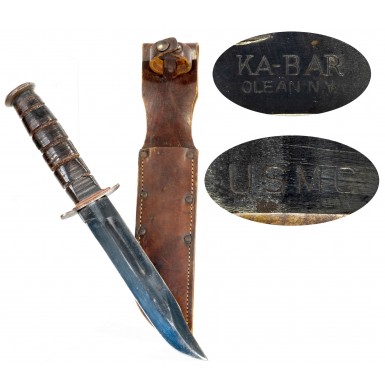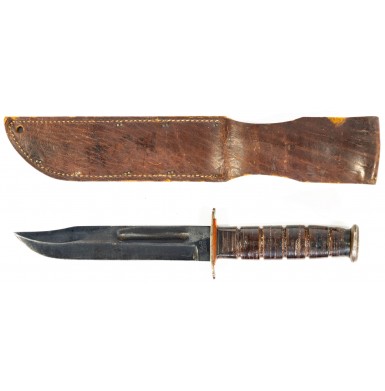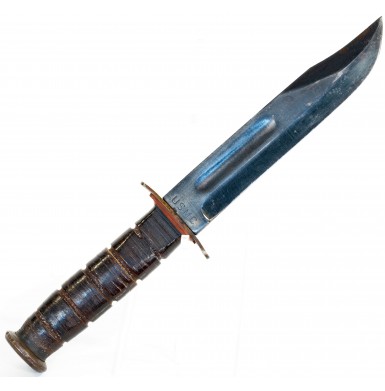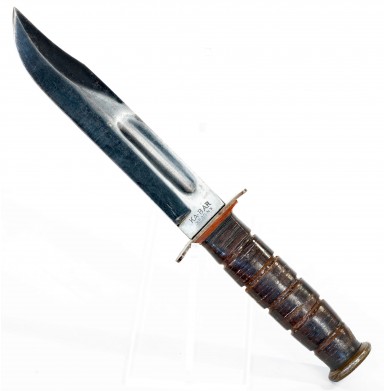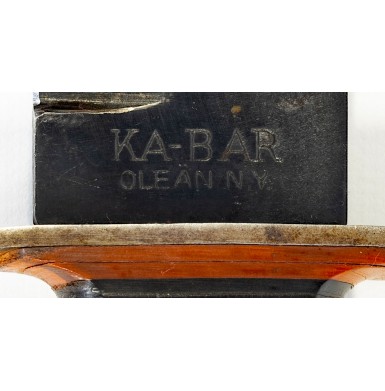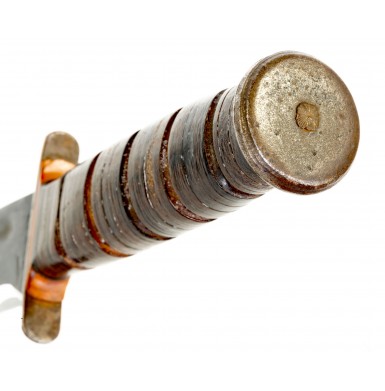Rare and Fine Early WWII Blade Blued USMC KABAR Fighting Knife with Correct Scabbard
- Product Code: EWSK-1671-SOLD
- Availability: Out Of Stock
-
$1,195.00
There is probably no US fighting knife more from the Second World War associated with the fighting in the Pacific theater than the USMC Mk 2 pattern combat knife, better known to the Marines who carried it at the KA-BAR. Marine Lieutenant Colonel Clifford H Shuey designed the USMC 1219C2 Combat Knife (later re-designated as the USMC Mk 2 Combat Knife) and eventually simply as “Knife, Fighting Utility” in 1942 and it was officially adopted in November of that year. The knife was essentially the same knife the Navy adopted as the USN Mk 2 and had a 7” clip-point, Bowie-style blade with steel cross guard and a hilt made of stacked leather washers. The overall length of the knife was 12” and the blades were delivered with a variety of finishes including blued, blackened, Parkerized or plated, depending upon the manufacturer; and in the period of time when the manufacturer produced the knives. In general, the highest level of polishing and finish was found on the early production knives that were often delivered with beautifully blued blades, while the later war knives often exhibited a lower level of metal polishing and surface preparation and were generally Parkerized. Pommel caps were secured by a variety of methods, including screwed on washers, peened tangs and pinned tangs, just to name a few. Some of the makers even used different methods to secure the pommel cap to the knife tang during the course of their production runs, with the later war knives typically adopting the less expensive and most expeditious methods of production. The initial deliveries were made by the Union Cutlery Company and were marked with their trademark name KA-BAR. Even though the knife was produced by three other companies during the war, the Marines referred to the knives generically as the “KA-BAR”, and still use that name for their fighting-utility knife today. The knives began to be issued to the Marines in early 1943.
While the Navy version of the knife was marked USN or USN Mk 2 on the blade and had the makers name on the opposite side, the Marine Corps knives were marked USMC on one side of the ricasso and with the makers name on the other side. Early US Navy knives were issued in leather sheaths, which were eventually replaced by gray composite sheaths by early-to-mid 1944. The salt air and sea spray that the navy knives were exposed to was very tough on the leather scabbards, so the composite scabbard was a better choice for long term use in such an adverse environment. Amazingly, even though the Marine knives saw use in equally harsh, if not harsher conditions, the Marines utilized leather sheaths throughout the entire war. Due to problems in the field with broken blades, the government ordered that the markings be moved from the blade ricasso to the cross guard in 1944. As a result, the early, blade marked knives are less common and more actively sought after than the later production, guard marked knives.
During the war Camillus, the Pal Blade Company and Robeson Shuredge also produced the “Ka-Bar” USMC fighting knife. Union Cutlery (KaBar) delivered the majority of the USMC fighting knives, with Camillus, PAL and Robeson delivering a significantly smaller number of knives, in that order. Today, Pal, and especially Robeson USMC knives are extremely rare and desirable for WWII USMC knife collectors. In particular the Robeson knives are highly prized as they were not only contractor who delivered the smallest number of knives, but they also delivered what were generally considered to be the highest quality knives.
This particular USMC 1219C2 Combat Knife was produced by the Union Cutlery Company of Olean, NY and is in VERY FINE condition. This is a fairly early war knife, with a blued blade and the red synthetic spacers between the guard and the leather washer hilt. Ka-Bar produced a wide variety of USMC knives in terms of finish, features, and markings. During the course of the war the firm delivered both blued and Parkerized knives, knives with two different types of maker markings, knives that were both stamped “USMC” on the ricasso and knives without that mark and without a guard marking either. They also delivered two distinctive types of hilt shapes, two different types of guards and most interestingly two distinctive blade types, with the earliest knives having a unique blunt-nosed profile. In his book U.S. and Allied Military Knives – World War II, Bill Walters identifies ten specific variations of USMC Ka-Bar knives that are blade marked and fifteen variations in the leather scabbards that accompanied them.
This particular knife is categorized as a “3rd Generation” Ka-Bar by Bill Walters. An Example is described on page 400 of his book and pictured on the following page as figure #7 and on page 403 where the first four generations of Ka-Bars are shown for comparison. The distinctive features of the 3rd Generation knives are the use of thin, beveled red spacers between the rear of the guard and the grip washers and the use of three thin black washers of the pommel cap. The third-generation knives were the last of the of the USMC Ka-Bar produced knives to use the red and black washers in the grip and was the last of the knives to use the thin pommel cap that is found on the first- and second-generation knives as well. They were also the last generation that had a significant taper in grip thickness close to the guard. The fourth-generation knives eliminated the use of the colored spacers and adopted a much thicker pommel cap. The third-generation knives were one of the last groups of blued blade knives as well. While the fourth-generation knives retained the blued blades with numerous other changes, the fifth-generation knives would introduce the Parkerized finish that would be used for the rest of the production.
As previously noted, this 3rd Generation USMC 1219C2 Combat Knife remains in VERY FINE condition. The obverse ricasso is crisply marked USMC and the reverse ricasso is clearly marked in two lines:
KA-BAR
OLEAN, N.Y.
As noted, the knife has a thinner pommel cap which is typical of the early production KaBar marked knives. The pommel cap is secured by a peen that is not ground smooth and flush as it was with the 1st and 2nd generation knives. The blade still retains about 85%+ of its original bright blued finish, with some scattered loss due to carry and use, some high edge wear and the expected thinning and light wear from being inserted and removed from the scabbard many times. The blade is in about FINE condition. It shows no significant post factory sharpening along either the primary or false edges of the blade. The blade is almost entirely smooth and shows no pitting but does show some areas of freckled surface oxidation and a few tiny spots of minor surface roughness. There are also a number of light surface scuffs and finish scratches that are the result of normal use. The steel crossguard is in good condition and shows none of the often-encountered bends that are quite typical of these knives. The guard shows some moderate surface oxidation on its surfaces. The peened pommel cap retains none of its original finish to speak of and has a medium pewter gray patina with a moderate amount of scattered surface oxidation. The leather washer hilt is in about FINE condition as well and shows only some light to moderate scuffing to the finish, the result of handling and use. The leather is free of any gouges or dings and has a smooth, dark brown surface, retaining some of its original finish as well. The hilt has five grooves and as noted has a pair of red and a single black spacer at the guard, which are thin and contoured and three thin black spacers at the pommel cap.
The knife is accompanied by an original leather scabbard. The scabbard is in about VERY GOOD+ to NEAR FINE condition. The scabbard is sewn and reinforced with nine rounded rivets. Walter’s shows six scabbard variants that are correct for the 3rd and 4th generation USMC Ka-Bar knives on pages 410-411, identified as items “C” through “H”. This scabbard is variant “D”. It was made with bright rivets, a tie down hole in the tip of the scabbard and is unmarked. Most of the USMC knife scabbards are unmarked, with the most commonly encountered exception being the ones made by Boyt that have their name, the year of production and “USMC” on the drop above the scabbard body. The scabbard shows moderate wear and use, commensurate with having been carried, subjected to moisture, and sweat and having seen real field use. The leather has darkened from its original light latigo color to a richer, darker brown with an orange tinge. There is some minor wear and damage to the tip of the scabbard, and the leather shows lots of scuffing and discoloration. The scabbard remains fully functional and useable. The belt loop remains in fine, solid, and fully usable condition and the original leather hilt-retaining strap is present and complete as well. The steel closure snap remains intact and fully functional. Both the snap and the steel reinforcement rivets all show a moderately oxidized brownish gray patina. The scabbard stitching remains essentially intact and tight with some wear but no apparent loss.
Overall, this is a really fine, early production blade marked, blued blade example of the classic USMC “KaBar” fighting knife. The knife is in lovely condition and shows real world use and carry but no abuse or damage. The knife is extremely attractive and displays wonderfully. As the blued blade marked knives with the peened pommels were the earliest production of the Union Cutlery knives, and saw the most service, they are extremely difficult to find in anything but well-used condition. The original leather scabbard remains in very nice condition with honest use and matches the knife perfectly. This is a really great complete set of a USMC fighting knife and scabbard, circa early-to-mid 1943. It would be a very nice addition to any WWII edged weapons collection, especially one that focuses on the US Marine Corps. The condition is such that it would be fairly difficult to upgrade this knife without significant effort and additional cost.
Tags: Rare, and, Fine, Early, WWII, Blued, Blade, USMC, KABAR, Fighting, Knife, with, Correct, Scabbard

